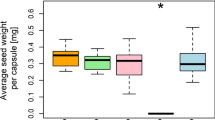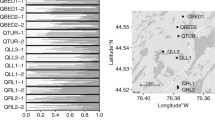Abstract
Amsinckia grandiflora (large-flowered fiddleneck)is an extremely rare California annual wildflower, known only from threepopulations. We conducted field and greenhouse experiments to compare the rareheterostyle with a cryptic self-incompatibility system (A.grandiflora) to a common, self-compatible, homostylous, sympatriccongener (A. tessellata). Inter-species comparisons ofadult plants suggested that in the greenhouse, A.grandiflora balances low floral seed set (seeds per flower) withincreased floral output (flowers/plant) and a greater number of flowers perinflorescence. Seed set from active self-, intra- and inter-morph pollinationswas high in A. grandiflora, indicating that the crypticself-incompatibility system does not prevent seed set in the species. In thefield, A. grandiflora floral output was only slightlygreater than for A. tessellata, and did not fully balance lowerfloral seed set. Amsinckia tessellata average seed weightwas lower than that of A. grandiflora, which, along with the lowernumber of flowers produced, indicated lower maternal investment per nutlet thanfor A. grandiflora. Under conditions of unlimited resources, itappears that A. grandiflora fitness is not intrinsicallylimited when compared to its weedy relative A. tessellata.The differences in nutlet output between A. grandiflora andA. tessellata under field conditions are more likely due todifferential responses to extrinsic factors such as competition and pollinatoravailability.
Similar content being viewed by others
References
Aizen M.A. and Paterson W.A. 1990. Acorn size and geographical range of plant species in relation to dispersal morphology an diaspore weight. Journal of Biogeography 17: 327-332.
Baskin J.M. and Baskin C.C. 1976. High temperature requirement for after-ripening in seeds of winter annuals. New Phytology 77: 619-624.
Bevill R.L. and Louda S.M. 1999. Comparisons of related rare and common species in the study of plant rarity. Conservation Biology 13: 493-498.
Byers D.L. and Meagher T.R. 1997. A comparison of demographic characteristics in a rare and a common species of Eupatorium. Ecological Applications 7: 519-530.
Cane J.H. and Tepedino V.J. 2001. Causes and extent of declines among native North American invertebrate pollinators: detection, evidence, and consequences. Conservation Ecology 5 [online] URL: http: / /www.consecol.org/vol5/ iss1 / art1: 1.
Carlsen T.M., Menke J.W. and Pavlik B.M. 2000. Reducing competitive suppression of a rare annual forb by restoring native California perennial grasslands. Restoration Ecology 8: 18-29.
Casper B.B. 1985. Self compatibility in distylous Cryptantha flava (Boraginaceae). New Phytologist 99: 149-154.
Cody M.L. 1986. Diversity, rarity, and conservation in mediterranean-climate regions. In: Soule M.E. (ed.), Conservation Biology: The Science of Scarcity and Diversity. Sinauer Associates, Inc., Sunderland, Massachusetts, pp. 122-152.
Evans R.A. and Young J.A. 1989. Characterization and analysis of abiotic factors and their influences on vegetation. In: Huenneke L.F. and Mooney H.A. (eds), Grassland Structure and Function: California Annual Grassland. Tasks for Vegetation Science 20. Kluwer Academic Publishers, Dordrecht, the Netherlands, pp. 13-28.
Fernald M.L. 1924. Isolation and endemism in northeastern America and their relation to the age and area hypothesis. American Journal of Botany 11: 558-572.
Fiedler P.L. 1987. Life history and population dynamics of rare and common mariposa lilies (Calochortus Pursh: Liliaceae). Journal of Ecology 75: 977-995.
Fiedler P.L. and Ahouse J.J. 1992. Hierarchies and cause: toward an understanding of rarity in vascular plant species. In: Fiedler P.L. and Jain S.K. (eds), Conservation Biology: The Theory and Practice of Nature Conservation, Preservation and Management. Chapman & Hall, New York, pp. 23-47.
Ganders F.R. 1976. Pollen flow in distylous populations of Amsinckia (Boraginaceae). Canadian Journal of Botany 54: 2530-2535.
Ganders F.R. 1979. The biology of heterostyly. New Zealand Journal of Botany 17: 607-635.
Gaston K.J. 1994. Rarity. Chapman & Hall, New York.
Haig D. and Westoby M. 1988a. Inclusive fitness, seed resources, and maternal care. In: Doust J.L. and Doust L.L. (eds), Plant Reproductive Ecology: Patterns and Strategy. Oxford University Press, New York, pp. 60-79.
Haig D. and Westoby M. 1998b. On limits to seed production. American Naturalist 131: 757-759.
Hamilton M.B. and Mitchell-Olds T. 1994. The mating system and relative performance of selfed and outcrossed progeny in Arabis fecunda (Brassicaceae). American Journal of Botany 81: 1252-1256.
Harper J.L. and Ogden J. 1970. Reproductive strategy of higher plants. I. The concept of strategy with reference to Senecio vulgaris L. Journal of Ecology 58: 681-698.
Heady H.F. 1988. Valley grassland. In: Barbour M.G. and Major J. (eds), Terrestrial Vegetation of California. California Native Plant Society, Sacramento, California, pp. 491-514.
Johnston M.O. and Schoen D.J. 1996. Correlated evolution of self-fertilization and inbreeding depression: an experimental study of nine populations of Amsinckia (Boraginaceae). Evolution 50: 1478-1491.
Kohn J.R. and Barrett S.C.H. 1992. Experimental studies on the functional significance of heterostyly. Evolution 46: 43-55.
Krebs C.J. 1989. Ecological Methodology. Harper Collins, New York, pp. 449-451.
Kunin W.E. and Gaston K.J. 1993. The biology of rarity: patterns, causes and consequences. Trends in Ecology and Evolution 8: 298-301.
Lewis H. and Raven P.H. 1958. Rapid evolution in Clarkia. Evolution 12: 319-336.
MacDonald S.E., Cinnappa C.C., Reid D.M. and Purdy B.G. 1987. Population differentiation of the Stellaria longipes complex within Saskatchewan' Athabasca sand dunes. Canadian Journal of Botany 65: 1726-1732.
Mal T.K. and Lovett-Doust J. 1997. Morph frequencies and floral variation in a heterostylous colonizing weed, Lythrum salicaria. Canadian Journal of Botany 75: 1034-1045.
Marr D.L. 1997. Impact of a pollinator-transmitted disease on reproduction in healthy Silene acaulis. Ecology 78: 1471-1480.
Ng S. and Corlett R.T. 2000. Comparative reproductive biology of the six species of Rhododendron (Ericaceae) in Hong Kong, South China. Canadian Journal of Botany 78: 221-229.
Oakwood M., Jurado E., Leishman M. and Westoby M. 1993. Geographic ranges of plant species in relation to dispersal morphology, growth form and diaspore weight. Journal of Biogeography 20: 563-572.
Ornduff R. 1976. The reproductive system of Amsinckia grandiflora, a distylous species. Systematic Botany 1: 57-66.
Pantone D.J., Pavlik B.M. and Kelly R.B. 1995. The reproductive attributes of an endangered plant as compared to a weedy congener. Biological Conservation 71: 305-311.
Parker I.M. 1997. Pollinator limitation of Cytisus scoparius (scotch broom), an invasive exotic shrub. Ecology 78: 1457-1470.
Pavlik B.M 1994. Tales of Success and Failure: Trends in Natural and Reintroduced Populations of Amsinckia grandiflora under Different Management Regimes. Prepared for the Endangered Plant Program. California Department of Fish and Game, Sacramento, California.
Pavlik B.M 1995. And the Beat Goes On: Populations of Amsinckia grandiflora under Different Management Regimes. Prepared for the Endangered Plant Program. California Department of Fish and Game, Sacramento, California.
Pavlik B.M., Ferguson N. and Nelson M. 1993a. Assessing limitations on the growth of endangered plant populations. II. Seed production and seed bank dynamics of Erysimum capitatum ssp. angustatum and Oenothera delcoides ssp. Howellii. Biological Conservation 65: 267-278.
Pavlik B.M., Nickrent D.L. and Howald A.M. 1993b. The recovery of an endangered plant. I. Creating a new population of Amsinckia grandiflora. Conservation Biology 7: 510-526.
Piper J.G., Charlesworth B. and Charlesworth D. 1986. Breeding system evolution in Primula vulgaris and the role of reproductive assurance. Heredity 56: 207-217.
Rabinowitz D. 1981. Seven forms of rarity. In: Synge H. (ed.), The Biological Aspects of Rare Plant Conservation. Wiley, New York, pp. 205-217.
Ray P.M. and Chisaki H.F. 1957a. Studies of Amsinckia. I. A synopsis of the genus, with a study of heterostyly in it. American Journal of Botany 44: 524-536.
Ray P.M. and Chisaki H.F. 1957b. Studies of Amsinckia. II. Relationships among primitive species. American Journal of Botany 44: 537-544.
Reinartz J.A. and Les D.H. 1994. Bottleneck-induced dissolution of self-incompatibility and breeding system consequences in Aster furcatus Asteraceae. American Journal of Botany 81: 446-455.
SAS 1990. SAS/STAT??User' Guide, Version 6. 4th edn, Vol 2. SAS Institute Inc., Cary, North Carolina, pp. 891-996.
Shoen D.J., Johnston M.O., L'Hereux A.-M. and Marsolais J.V. 1997. Evolutionary history of the mating system in Amsinckia (Boraginaceae). Evolution 51: 1090-1099.
Silvertown J.W. and Lovett-Doust J. 1993. Introduction to Plant Population Biology. Blackwell Scientific Publications, London, pp. 168-170.
Stebbins G.L. 1942. The genetic approach to problems of rare and endemic species. Madroño 241-257.
Tabachnik B.G. and Fidell L.S. 1996. Using Multivariate Statistics. Harper Collins, New York.
Thompson K., Gaston K.J. and Band S.R. 1999. Range size, dispersal and niche breadth in the herbaceous flora of central England. Journal of Ecology 87: 150-155.
Thomson J.D. 2001. Using pollination deficits to infer pollinator declines: can theory guide us? Conservation Ecology 5 [online]. URL: http: / /www.consecol.org/ vol5/ iss1 / art6: 6.
U.S. FWS 1997. Large-flowered fiddleneck. Amsinckia grandiflora Recovery Plan. U.S. Fish and Wildlife Service, Portland, Oregon, 44 pp.
Venable D.L. and Brown J.S. 1988. The selective interactions of dispersal, dormancy and seed size as adaptations for reducing risk in variable environments. American Naturalist 131: 360-384.
Venable D.L. and Lawlor L. 1980. Delayed germination and dispersal in desert annuals: escape in space and time. Oecologia 46: 272-282.
Waser N.M. 1978. Competition for hummingbird pollination and sequential flowering in two Colorado wildflowers. Ecology 59: 934-944.
Weller S.G. and Ornduff R. 1977. Cryptic self-incompatibility in Amsinckia grandiflora. Evolution 31: 47-51.
Weller S.G. and Ornduff R. 1989. Incompatibility in Amsinckia grandiflora (Boraginaceae): Distribution of callose plugs and pollen tubes following inter-and intramorph crosses. American Journal of Botany 76: 277-282.
Weller S.G. and Ornduff R. 1991. Pollen tube growth and inbreeding depression in Amsinckia grandiflora (Boraginaceae). American Journal of Botany 78: 801-804.
Wilson S.D. and Tilman D. 1993. Plant competition in relation to disturbance, fertility and resource availability. Ecology 74: 599-611.
Young J.A., Evans R.A. and Eckert Jr R.E. 1968. Germination of medusahead in response to temperature and after-ripening. Weed Science 16: 92-95.
Zar J.H. 1984. Biostatistical Analysis. Prentice Hall, Englewood Cliffs, New Jersey.
Author information
Authors and Affiliations
Rights and permissions
About this article
Cite this article
Carlsen, T.M., Espeland, E.K. & Pavlik, B.M. Reproductive ecology and the persistence of an endangered plant. Biodiversity and Conservation 11, 1247–1268 (2002). https://doi.org/10.1023/A:1016066618824
Issue Date:
DOI: https://doi.org/10.1023/A:1016066618824




